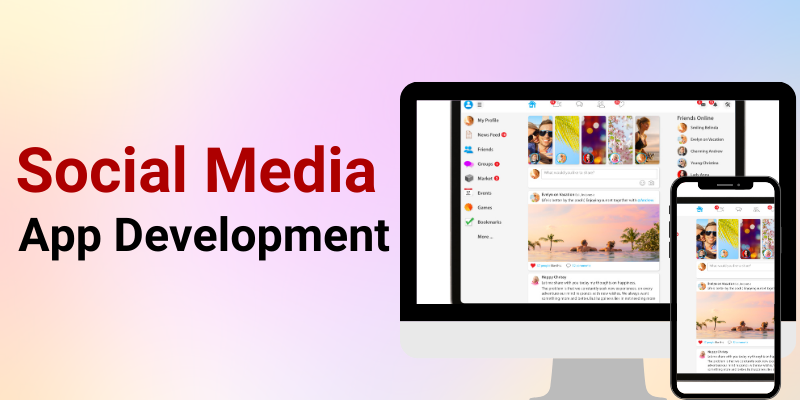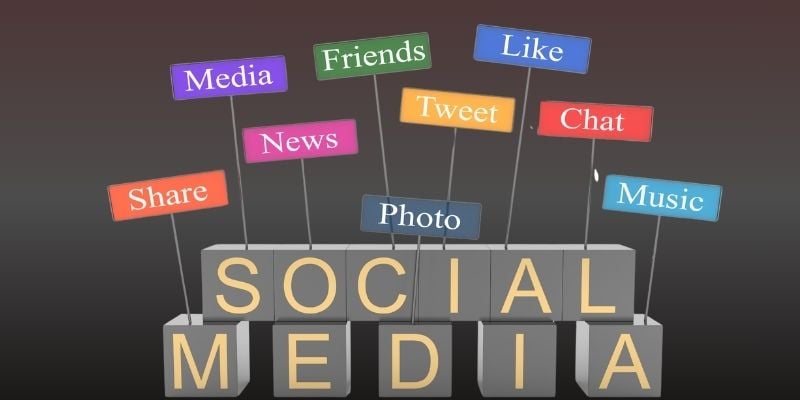We've got a question for the people on your mobile: Are they the ones you most frequently use? We'll wager that most of these are social media apps. Social media applications have become an essential aspect of our daily lives. This isn't just the mainstream social media apps like Facebook, Instagram, Twitter, and Snapchat. New and innovative social media platforms are being created and made accessible to the general masses, while they are not all popular successes.
Accessibility to apps like these has allowed any smartphone user to make media. Users spend approximately 2 hours and 27 minutes using social networks daily. Posting pictures, connecting with their peers, and scrolling through news feeds; taking/posting selfies/selfies for upload; offering/buying products/ services or buying and sharing coupons, etc. According to research conducted by a company that estimates there'll be 3.6 billion social media users in the year ahead, more than 8 out of 10 Internet users. That's an excellent motive to think about Live Social Media App Development. However, the design and development process could seem overwhelming as there are many aspects to consider when developing your mobile social media application.
Here's a list of the most popular forms of social media apps, the most popular technologies implemented, and the technology stack used to develop them.
Essential Features Of a Social Media Application
These features significantly influence the development costs. The more features you incorporate into your application, the more it will cost. Therefore, to remain within the budget, you must know the most critical capabilities required for your social media application design and include the most sophisticated features you might miss initially.
MVP (Minimum Viable Product)
The MVP category includes the features that you must have. The functions of profiles, feeds, connections, and more define the MVP social mobile platform's features.
UI/UX Design
Designing for social media apps is remarkably demanding as every user demands an individual design path and a user-friendly interface. The key is to agree on a style that most viewers would want. This is why you require a highly experienced Social Media Platform Development Team who can guide you through every step of the process.
Also Read: How to Make a Social Media App from Scratch
Profile
Profile creation is any app development application's initial and most important feature. It permits users to include their personal information such as name, gender, age, geographic photograph, and other information. The most effective method to build user profiles is to link the app to a current social media account through which the data is retrieved. A different option is the signup procedure, which allows you to add your account update with your email address and password. This takes more work and isn't something that people are used to.
Feeds
It is the central area for any social media platform. Feed is where users post material in images, videos, audio, and status updates. Thus, the social media app you're developing must be able to share pictures, videos, and status updates. All you need to do is upload and share the content and specify the group you wish to connect with. Social media applications demonstrate that sharing videos or similar content will help you build a presence and proliferate.
Connections
Connections can be content, an event, a group, social networks, text messages, address book searches, and recommendations. The connection to content is entirely dependent upon the user. They could be tourists as well as readers or avid users. They are groups where members can be connected on a massive size. Sending invitations to events or selling tickets to events on social networks is the most effective option to make money from applications for social media. Additionally, it helps to increase relationships in the realm of social media.
Signup
Customers should be offered various registration options to make it simple to access your website and sign up. You can, for instance, include options such as email, password, number, and password or a guest user option. Incorporating the "Forgot Password" feature is essential to making social media apps more straightforward. Social media app developers can use Facebook, Google SDK, Amazon SNS, and SES to make it easier for technology-related purposes.
Also Read: Best Tech Stack to Make a Social Media App
Chat
If you're planning to build a social media application such as WhatsApp or Instagram, it is essential to incorporate a dazzling chat function. Relaying information such as messages, images, or videos between platforms is integral for creating successful social media apps. Group chats and channels allow users to communicate with a group of users in a group chat. It is possible to use socket.io to build scalable chats.
Also Read: Top Trending Social Media Platforms
Search Bar
People require a user-friendly search feature to identify the influencers or friends they want to follow. This feature can, for instance, be accessed at user names, labels, or places.
Media Sharing
These applications allow users to share various media documents (images or videos, GIFs, and more). Some of the most well-known sites with media-sharing features are Instagram, Snapchat, YouTube, and Vimeo.
Push Notifications
Push messages are beneficial for engaging users. Some types of push messages that users receive are a new post in the group they're signed up to, a brand new message, or a reply or comment to their message.
Advanced Features
While you're familiar with the features of essential Social Media App Development Solutions, you are also aware of the more sophisticated features that will make your app a hit. Many people believe that the more significant the number of features an app has, the more user interaction it'll receive. But this isn't as simple as that. Incorporating features that aren't needed and don't fit with your needs can only increase the cost and complexity of creating a social media app. Instead of clogging the application with many features you don't need, focus only on the essential features your application will require.
Augmented Reality And Face Filters
Trend-setters in this category include Snapchat, Instagram and TikTok. The humorous filter effects for faces are prevalent and do not disappear soon. To make a social networking app stand out, it is possible to incorporate various effects and filters into the image or video. Instagram and Snapchat have many AR filters, from animal ears to masks for beauty. Exciting filters can draw users to the social network application. To add AR filters to your social media apps, developers must use ML Kit and ARCore. AR technology gives a distinctive experience for users.
Live Streaming (Live Videos)
This feature is currently accessible in some well-known social media applications. People prefer to watch live streams rather than read media content. Since people today prefer to watch videos rather than read, video content is much more popular than written content. The reason is their short attention span and also because visual information is easier to understand.
Story Content
It's the kind of post that stays in your feed for as long as 24 hours before disappearing. In the end, Snapchat and Instagram are at the top of the list. Due to stories, people are spending more time on social media platforms daily. Aren't stories a great strategy to get users hooked?
Editing
Allowing users to alter their photos on your social media platform is a good idea. For example, you could offer options to crop and rotate pictures, eliminate unwanted objects, make collages, etc.
Location-Based Content
Another exciting aspect of a social media application is its ability to display content in accordance with the user's geographical location. It analyzes where the user is and displays content others share in that area. Additionally, users can post their locations to their photos or videos.
Technology Stack For Social Media App Development
Technology stacks (also referred to as tech stacks or solution stacks) are the combination of the technologies used by a business to create and manage an application. Simply put, they are an amalgamation of programs, programming languages, frameworks, databases, and frameworks put together to construct and manage an application.
Below are the most widely utilized development tools to aid in developing apps for social media.
Front-End Development
Front-end development is the process of creating a graphically designed user interface on an online site—that is, the portion of your site that visitors will be able to view and interact with. Front-end development involves coding and designing visual elements users click while ensuring that they function.
Also Read: Top Social Media App Development Trends
Ionic, React, and Redux are the most well-known alternatives for developing front-end applications. The most widely used open-source frameworks include AngularJS and ReactJS, which Google and Facebook created. These frameworks are most popular for mobile application development with a front end.
Angular
It's an enormous web application structure based on TypeScript, which is open-source and managed by Google's Angular team and a network of companies and individuals.
ExpressJs
It's a cost-free and open-source backend Web app framework to the Node.js framework licensed by the MIT license. It is used to develop APIs and web applications.
ASP.NET
The technology was developed by Microsoft, ASP.NET, an open-source server-side web application framework that web designers can use to build interactive web pages and applications.
Backend Development
Backend development involves the creation of codes that make the communication between databases and an application feasible. Backend developers are accountable for managing the back end of the website. This includes servers, databases, and applications - parts hidden from visitors.
Also Read: Reasons to Go for Social Media App Development
Backend development involves developing software for servers, focusing on the elements that can't be seen on a web page. Node.js is an innovative technology used to build fluid, data-driven apps. It's ideal for making applications for social media that include chats, likes, and comments. It's also great at processing data. Integrating it with Ember.js can help create scalable applications. The microservice application strategy must be followed to ensure your app is expandable. When making a microservice to support the social network app, it's simpler to scale as it will only affect a particular portion of the site if there is a problem.
They are among the most well-liked web development frameworks that backend the internet.
Django
Django is an entirely free and open-source Python-based web framework for rapidly developing reliable and secure websites. It uses the architectural model template views that allow for quick and efficient processing of things.
Laravel
Laravel is an entirely free and freely available PHP web framework that simplifies the everyday tasks of most web applications, such as authentication, session, and routing, and ensuring development.
CakePHP
CakePHP is an open-source web framework written entirely in PHP that follows a model-view-controller paradigm. The structure is modelled following the concepts developed in Ruby on Rails and helps programmers build web applications.
Falcon
Falcon is a platform from CrowdStrike designed to prevent security breaches by utilizing a range of cloud-based technologies that can ward off all kinds of attacks. This includes malware-related attacks. It's an open-source framework released under the terms of the BSD License.
Programming Languages
The programming languages function in the background as tools to develop backend applications and form the basis for a social media application. Pick a programming language most closely related to your app's primary purpose because everything depends on how well the app's language works.
We will look at the top programming languages for social application development.
Java
Java is a stalwart developing an object-oriented program and platform-oriented software language with many open-source libraries and tools. It has been in use for more than two decades. It's a robust design that is fast and safe. Because of its Java Virtual Machine (JVM),it doesn't need a compiler and is widely sought-after by developers. It can accelerate the process of development as well. Its syntax and rules are built upon C as well as C++ language.
PHP
A different programming language that is reliable, PHP, is a general-purpose scripting programming language focusing specifically on web development. The flawless program aids in social media. Many large corporations, such as Facebook, utilize this programming language to make smoother use of their platforms.
.NET
.NET isn't considered to be a programming language. It is more of a framework (another backend development tool) that Microsoft developed. It aids creators of programs to work inside Microsoft. NET. Microsoft.NET framework.
Perl
Even though Perl isn't a universally popular choice for programmers (like Java),it is known to be faster and more effective than many contemporary languages and produces stable software. Perl was initially designed to handle text, but nowadays, it is widely used in other areas like system administration, internet development, networking, and programming. However, it excels when designing dynamic websites.
Python
Python is like Java in several ways. It's faster than Java but isn't as safe and is designed to be more user-friendly. It's an object-oriented high-level programming language used to create websites and applications to automate work tasks and analyze data. Significant companies like YouTube, Reddit, and Pinterest use Python within their platforms.
Top Development Platforms
Let's look at some of the most popular platforms for creating social media applications.
- React Native
React Native is one of the most popular frameworks for Cross-PlatformSocial Media App Development. Created through Facebook, React Native enables the creation of iOS and Android applications using React and JavaScript. Many popular social media apps, including Facebook, Instagram, Pinterest, and Skype, use Skype to react Native, striking the perfect equilibrium between social media app developers' productivity and high-performance applications designed for social situations.
Flutter
Flutter is a wildly popular cross-platform development tool that Google maintains to create mobile applications. If you are a social media application developer seeking an easy-to-master and flexible framework, Flutter can be a great selection.
Parse Server
Parse Server is an attractive open-source option for those searching for a backend-as-a-service system. It began as the Parse platform, which powered large applications like Tinder. Startups and entrepreneurs focused on developing app logic find Parse Server easier to launch apps without setting up a complicated backend. However, compared to low-code tools, it requires some programming expertise.
Cloud Firestore
In Firebase's range of products to help mobile developers, Cloud Firestore stands out as an excellent instant NoSQL database to support the backend requirements of social applications. Some popular social media apps have embraced Cloud Firestore to meet the needs of mobile social interaction. Cloud Firestore's real-time data streaming works very well with notification-driven social interaction scenarios.
AppGyver
For teams that aren't technical and have limited engineers who want to create basic social applications quickly, AppGyver is a low-code option to think about. Within its scope, AppGyver enables the launch of essential social apps without code. However, custom-built development is advised for more complicated platforms.
Tips To Choose The Best Tech Stack For Social Media App Development
There are a variety of technological stacks you can select to work with. But if you're in the process of selecting which one you like most, it is essential to be prepared with a solid plan for your application. This will ensure that the mobile app that you design has a professional appearance and is efficient, as well as flexible, reliable, secure, and maintainable.
When creating this plan, it is vital to be aware of specific crucial points that are crucial in determining the outcome.
Let's look at it!
App Requirements
Every app differs from other apps in many different ways. It is the device on which the application will operate, the networks it requires to function, the expected user experience, its launch time, the platform on which it runs, and numerous other aspects that differentiate each app from the others. These elements, and many additional factors, work together to aid the app developer in deciding which framework, library program, and language they will need to employ for the most effective result.
Goals Of The App
The purpose or end objective of the application is crucial when it comes to the technology stack that a developer selects to build the application. In this case, for instance, the technology stack may drastically differ when developing applications with a high latency rate compared to a fast-response mobile application with lower latency. Suppose the app for mobile relies on a lot of load processing. In that case, it is necessary to have the most robust technology stack compared to a mobile app built with precisely optimized interactions.
Skills Set In The Company
There are a variety of frameworks and languages that produce the same results but possess specific commonalities that differentiate each from the others. If you had to pick between two tech stacks that seem very similar to one and the other, it's best to choose one that aligns according to the strengths of Hire Social Media App Developers. If you push your development team to select one that isn't their own, the effort will rise, as would the amount of time needed to construct the technology. But if you offered the team a stack of technology that the team members are familiar with, then the speed of development would not only improve, but it's also likely to improve.
Also Read: Why You Should Hire Social Media App Developers
The Company Responsible For The Technology
The parent company for your choice of technology stack is vital for the development of your mobile application. Some established brands offer superior documentation and customer support compared to other brands. It's normal for Google, Microsoft, and Adobe to provide exceptional community support and more advanced development options than Facebook and React Native.
Ability To Run On a Variety Of Platforms
If we contrast an application that runs on one platform to one that runs on any platform, it will show many differences between the stacks of technology used to develop both. The same goes for the tools needed for the type of scale you'll require within your mobile app so that it can be used on different platforms. It would be completely different in comparison to the set of tools needed to develop Native App Development.
Security Concerns
A modern smartphone app development technique that is worth its weight can ward away any vulnerabilities in protection that an application could face after it is launched in the marketplace. It can be challenging to secure your app if the platform you choose is not adequately defined or requires the writing of lengthy programs, which can increase the dangers throughout the creation process.
Also Read: Complete Guide To Social Media App Development
One of the most crucial aspects to consider is the skill level the person is developing. No matter what technology stack you're using, mobile application hackers could exploit the weaknesses you leave behind during creation. That's why, in addition to selecting a technology stack, the developers' team must also be competent.
Technology Compatibility With The One You're Already Using
Select a technology stack compatible with the technologies utilized within an app. This is crucial if you introduce the new tech stack following the social media application development process. It is essential to verify the compatibility of your technology stack with the technologies used in your project. It's necessary to verify compatibility between your chosen tech stack and other tools that you intend to incorporate into the future.
Conclusion
As you navigate the multifaceted web of social media app design, deciding on the technology stack becomes an important decision, one that goes beyond mere functionality and code. It's about creating a digital environment where technology does not just support but also improves human connection. The software to develop a social media app in 2024 includes React Native, Flutter, Django, Parse Server, Cloud Firestore, and AppGyver, among others. Be sure to carefully evaluate the platforms of your choice, as well as budgets, timelines, and technical capabilities, which will assist in finding the right mix of apps and tools to meet an app's demands.
Native development kits allow the highest performance; cross-platform applications allow speedier prototyping. For simple MVPs, low-code tools like AppGyver allow quick validation. Emerging technologies, including AI and AR, are being more broadly implemented and accepted, offering us novel opportunities to enhance user interactions and social connections. In the end, there's no universal technology stack. A partnership with a skilled firm that develops apps for social media could enhance your capabilities and help implement a social media strategy to fruition.
FAQs
Questions on the social media app development
1. What Is a Social Media App?
Social media software, sometimes called social software, allows professional and personal social networking as well as multimedia tools built on the web. It is focused on establishing connections between users and enhancing their interactions and conversations.
2. How Long Will It Take To Create a Social Media Application?
Time spent developing apps for social media is mainly dependent on the application's level of complexity, functions, and capabilities, as well as the developers' knowledge and experience. Additionally, applications with various dimensions and features come with distinct app development timeframes.
3. What Is The Price Of Developing a Social Media Application?
The price of creating social media platforms with complex functions and architecture with support for two or more channels could be more fantastic than $110,000. If you plan to develop your social networking application using an MVP, you can expect to spend between $20,000 and $40k, depending on your specifications.
4. What Are The Factors That Make An Online Social Media Site Effective?
A well-designed social media app or platform lets users be engaged with your content to the maximum extent possible. One of the most sought-after strategies that businesses employ when making social media apps include:
Imagine yourself in the viewer's in the audience's
Choose a specific area and make sure you cater to it fully
Follow and observe your competition
Maintain the current trends
5. How Do I Increase Users' Engagement On Facebook And Other Social Media Sites?
Make sure that the onboarding process is smooth. Implement gamification components and use push notifications to the proper extent. Create a sense of community with interactive features that allow users to create content. Study user behavior data to enhance and tweak applications' features continuously.
6. What Is The Most Effective Platform For Developing Social Media Applications?
The technology stack you choose influences several aspects of mobile app development. The stack of technology you pick for your mobile application determines what kind of app is sturdy and defines its future scalability (or its absence). Picking the wrong or inappropriate technology stack will not only affect your app's present efficiency but also hinder future growth.










